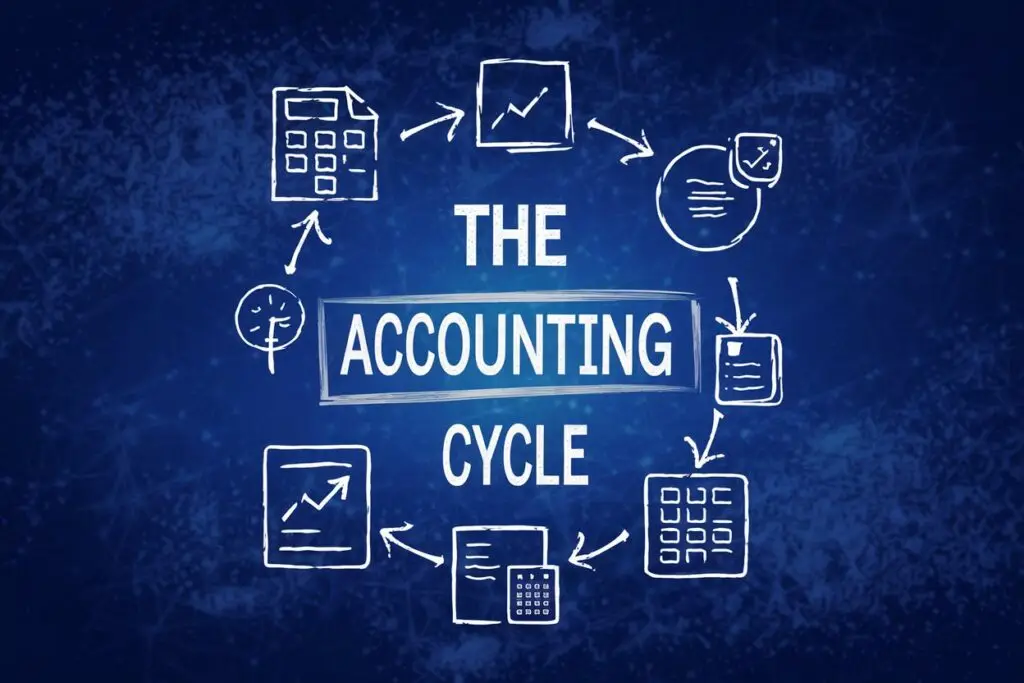Introduction
The accounting field may appear intimidating due to its specialized terminology and intricate procedures. Nonetheless, the accounting cycle provides a systematic approach to maintaining orderly and precise financial records. In this article, we simplify the accounting cycle, offering clear definitions, explanations, and useful tables for better understanding.
What is the Accounting Cycle?
The accounting cycle is a systematic process that businesses use to identify, record, and analyze financial transactions. This cycle is crucial for maintaining clear and accurate financial records, making informed business decisions, and providing stakeholders with essential financial information.
As Benjamin Franklin wisely stated:
“An investment in knowledge pays the best interest.”
Investing time in understanding the accounting cycle will surely pay off, whether you’re managing a personal budget or running a business.
9 Steps in the Accounting Cycle
The accounting cycle consists of a series of steps that provide a graphical representation of the flow of financial information. Let’s break down these steps in detail:
| Step | Description |
|---|---|
| 1. Identify Transactions | Recognize and analyze all financial transactions. |
| 2. Journalize | Record transactions in a journal (bookkeeping system). |
| 3. Post to Ledger | Transfer journal entries to the general ledger. |
| 4. Prepare Trial Balance | Create a trial balance to ensure debits and credits match. |
| 5. Adjust Entries | Make necessary adjustments for accruals and deferrals. |
| 6. Prepare Adjusted Trial Balance | Verify adjusted accounts are balanced. |
| 7. Financial Statements | Create income statements, balance sheets, and cash flow statements. |
| 8. Closing Entries | Close temporary accounts to start fresh for the next period. |
| 9. Post-Closing Trial Balance | Ensure accounts are balanced after closing entries. |
1. Identify Transactions
This step involves recognizing all financial transactions that affect the business. It’s crucial to keep track of every dollar earned or spent.
2. Journalize
Once you identify transactions, the next step is to record them in a journal that logs each transaction in chronological order.
3. Post to Ledger
After journalizing, you transfer the entries to specific accounts in the general ledger, which helps you categorize and summarize financial data.
4. Prepare Trial Balance
Accountants prepare a trial balance to verify that debits and credits are equal, ensuring the books are balanced.
5. Adjust Entries
At the end of the accounting period, adjustments are made for any accrued revenues and expenses or deferred revenues. This is important for aligning the incomes and expenses accurately.
6. Prepare Adjusted Trial Balance
After making the necessary adjustments, we prepare a new trial balance to ensure that the entries remain balanced.
7. Financial Statements
The next step involves preparing key financial statements like the income statement, balance sheet, and cash flow statement. These documents provide a snapshot of the financial health of the business.
8. Closing Entries
At the end of the accounting period, temporary accounts (like revenues and expenses) must be closed to reset their balances to zero for the next period.
9. Post-Closing Trial Balance
Finally, a post-closing trial balance is generated to ensure all accounts are balanced after the closing entries are done.
Why is the Accounting Cycle Important?
The accounting cycle is not just an academic concept; it holds real-world applications and importance:
- Accuracy: Regularly completing an accounting cycle aids in maintaining precise financial records.
- Regulatory Compliance: Organizations need to follow a standard process to comply with legal and tax regulations.
- Decision Making: Access to current financial information supports better managerial decisions.
- Financial Health Monitoring: Consistent tracking helps businesses monitor and improve their financial health.
FAQs about the Accounting Cycle
Q1: How long does the accounting cycle take?
A1: The duration of the accounting cycle varies based on the size of the organization and its number of transactions. Typically, it aligns with the accounting period, which can be monthly, quarterly, or annually.
Q2: What is the significance of a trial balance?
A2: A trial balance is critical as it verifies that all debits and credits are equal, serving as a preliminary check before creating financial statements.
Q3: Can small businesses use the accounting cycle?
A3: Yes! The accounting cycle is applicable to businesses of all sizes, ensuring that they keep accurate financial records.
Q4: What happens if errors are found in the trial balance?
A4: If discrepancies are found, it’s essential to trace back through the journal entries and ledger accounts to identify and correct the errors.
Conclusion
Understanding the accounting cycle is a vital part of managing finances, whether for personal accounts or an entire organization. By following these steps, individuals and businesses can ensure their financial records are accurate and compliant. Plus, as you grow more familiar with the cycle, it will feel less intimidating and more like an essential tool for achieving financial success!


